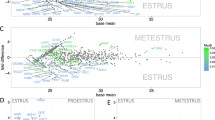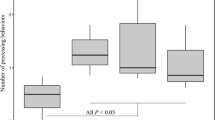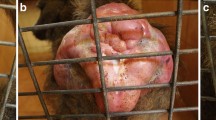Abstract
The responses of normal male hamsters to the odors of several components of estrous female hamster vaginal discharge (FHVD) were quantified with a two-bottle preference test in order to clarify the role of dimethyl disulfide (DMDS) and dimethyl trisulfide (DMTS) in the attraction of males to females. These two compounds were originally isolated and identified in two separate, behaviorally active fractions of FHVD, one containing DMDS and the second containing DMTS. However, only authentic DMDS proved to be attractive to males; DMTS was inactive in the amounts tested (50 ng to 10 μg). When smaller amounts of highly purified samples of DMTS (0.03–3.32 ng) are assayed, measurable amounts of activity are obtained. This activity of authentic DMTS is not due to any intrinsic activity of its own but rather can be ascribed to the activity of the residual DMDS (0.07%) that it contains. Highly purified samples of authentic DMDS (containing 0.03% DMTS) were again found to be attractive to males. Doses as small as 500 fg were significantly active when compared to controls. Arguments are presented suggesting that the behaviorally effective dose of DMDS is several orders of magnitude less than 500 fg. Deliberate mixtures of DMDS and DMTS failed to show any synergistic effects. In fact, at the two lowest doses examined (0.1 and 0.46 ng total sulfides), the response obtained with the mixture was smaller than that expected if DMDS were the only odorant in the solution. Therefore, DMTS seems to suppress the activity of DMDS.
Similar content being viewed by others
References
Bartoshuk, L.M., andCleveland, C.T. 1977. Mixtures of substances with similar tastes. A test of a psychophysical model of taste mixture interactions.Sensory Processes 1:177–186.
Berglund, B. 1974. Quantitative and qualitative analysis of industrial odors with human observers.Ann. N.Y. Acad. Sci. 237:35–51.
Besglund, B., Berglund, U., andLindvall, T. 1971. On the principle of odor interaction.Acta Psychol 35:255–268.
Berglund, B., Berglund, U., Lindvall, T., andSvensson, L.T. 1973. A quantitative principle of perceived intensity summation in odor mixtures.J. Exp. Psychol. 100:29–28.
Cain, W.S. 1975. Odor intensity: Mixtures and masking.Chem Senses Flavor 1:339–352.
Guyton, A.C. 1947. Measurement of the respiratory olumes of laboratory animals.Am. J. Physiol. 150:70–77.
Johnston, R.E. 1977. Sex pheromones in golden hamsters, pp. 225–249,in D. Müller-Schwarze and M.M. Mozell (eds.). Chemical Signals in Vertebrates. Plenum Press, New York.
Kaissling, K.E. 1971. Insect olfaction, pp. 351–431,in L.M. Beidler (ed.). Olfaction. Springer-Verlag, New York.
Kaissling, K.E., andPriesner, E. 1970. Die Riechschwelle des Seidenspinners.Naturwissenschaften 57:23–28.
Macrides, F., Johnson, P.A., andSchneider, S.P. 1977. Responses of the male golden hamster to vaginal secretion and dimethyl disulfide: Attraction versus sexual behavior.Behav. Biol. 20:377–386.
O'connell, R.J., Singer, A.G., Macrides, F., Pfaffmann, C., andAgosta, W.C. 1978. Responses of the male golden hamster to mixtures of odorants identified from vaginal discharge.Behav. Biol. 24:244–255.
Pickering, T.L., Saunders, K.J., andTobolsky, A.V. 1967. Disproportionation of organic polysulfides.J. Am. Chem. Soc. 89:2364–2367.
Regnier, F.E., andGoodwin, M. 1977. On the chemical and environmental modulation of pheromone release from vertebrate scent marks, pp. 115–133,in D. Müller-Schwarze and M.M. Mozell (eds.). Chemical Signals in Vertebrates. Plenum Press, New York.
Siegel, S. 1956. Nonparametric Statistics for the Behavioral Sciences. McGraw-Hill, New York.
Singer, A.G., Agosta, W.C., O'connell, R.J., Pfaffmann, C., Bowen, D.V., andField, F.H. 1976. Dimethyl disulfide: An attractant pheromone in hamster vaginal secretion.Science 191:948–950.
Author information
Authors and Affiliations
Additional information
This work was supported by NINCDS grant NS14453, NICHHD grant HD11164, and Rockefeller Foundation grant RF70095.
Rights and permissions
About this article
Cite this article
O'connell, R.J., Singer, A.G., Pfaffmann, C. et al. Pheromones of hamster vaginal discharge Attraction to femtogram amounts of dimethyl disulfide and to mixtures of volatile components. J Chem Ecol 5, 575–585 (1979). https://doi.org/10.1007/BF00987842
Received:
Revised:
Issue Date:
DOI: https://doi.org/10.1007/BF00987842




